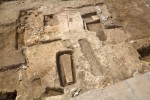 On Tuesday, July 23rd, the University of Leicester team excavating the Grey Friars site set about taking the lid off the medieval stone coffin discovered last September during the Richard III dig in what was once the choir of the church. Made out of carved limestone, it’s the first intact medieval stone coffin ever discovered during an archaeological dig in Leicester. The box is 2.12 meters long (seven feet), .6 meters (two feet) wide at the wide end were the head would be placed, .3 meters (one foot) wide at the narrow feet end and .3 meters deep. The heavy stone lid does not match the coffin and the mortar is damaged in some areas, suggesting it may have been added after the original internment, then removed or at least tampered with.
On Tuesday, July 23rd, the University of Leicester team excavating the Grey Friars site set about taking the lid off the medieval stone coffin discovered last September during the Richard III dig in what was once the choir of the church. Made out of carved limestone, it’s the first intact medieval stone coffin ever discovered during an archaeological dig in Leicester. The box is 2.12 meters long (seven feet), .6 meters (two feet) wide at the wide end were the head would be placed, .3 meters (one foot) wide at the narrow feet end and .3 meters deep. The heavy stone lid does not match the coffin and the mortar is damaged in some areas, suggesting it may have been added after the original internment, then removed or at least tampered with.
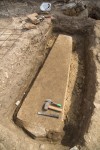 After a night of rain, the entire site was pockmarked with puddles, but the team had thoughtfully put a tent over the stone coffin so they wouldn’t have to wade hip-deep into mud to examine it. The team cut the mortar seal all the way around and placed straps under the lid. Eight people were enlisted to hold on to the straps and lift the solid stone lid up and to the side where it was set down carefully on the ground. Inside was another coffin, this one a lead wrapper 5 millimeters-thick embracing the body. We know there’s a body inside because the bottom of the lead coffin was damaged leaving the feet exposed. This is further evidence that the coffin was exhumed, opened and re-buried.
After a night of rain, the entire site was pockmarked with puddles, but the team had thoughtfully put a tent over the stone coffin so they wouldn’t have to wade hip-deep into mud to examine it. The team cut the mortar seal all the way around and placed straps under the lid. Eight people were enlisted to hold on to the straps and lift the solid stone lid up and to the side where it was set down carefully on the ground. Inside was another coffin, this one a lead wrapper 5 millimeters-thick embracing the body. We know there’s a body inside because the bottom of the lead coffin was damaged leaving the feet exposed. This is further evidence that the coffin was exhumed, opened and re-buried.
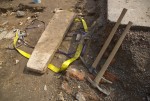 No identifying marks have been spotted on either of the coffins, which is a shame because a nice handy label is the only way to know for sure who was buried in them. There was a rough cross soldered into the lead, which could suggest it contained someone or something (a relic, for example) of religious significance. Then again, anybody Christian buried in two expensive coffins in a prime position under a church choir is just as likely to have a little cross iconography in the mix somewhere.
No identifying marks have been spotted on either of the coffins, which is a shame because a nice handy label is the only way to know for sure who was buried in them. There was a rough cross soldered into the lead, which could suggest it contained someone or something (a relic, for example) of religious significance. Then again, anybody Christian buried in two expensive coffins in a prime position under a church choir is just as likely to have a little cross iconography in the mix somewhere.
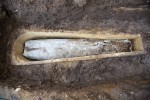 It was certainly someone of great consequence. Likely candidates include Peter Swynsfeld (d. 1272), William of Nottingham (d. 1330), both leaders of the English Grey Friars order, and a man described in the documentary record as “a knight called Mutton, sometime mayor of Leicester,” who researchers believe was Sir William de Moton of Peckleton (d. between 1356 and 1362). A large limestone coffin would have been difficult and expensive to make. Sufficient lead to make a wrap-around coffin was also extremely expensive.
It was certainly someone of great consequence. Likely candidates include Peter Swynsfeld (d. 1272), William of Nottingham (d. 1330), both leaders of the English Grey Friars order, and a man described in the documentary record as “a knight called Mutton, sometime mayor of Leicester,” who researchers believe was Sir William de Moton of Peckleton (d. between 1356 and 1362). A large limestone coffin would have been difficult and expensive to make. Sufficient lead to make a wrap-around coffin was also extremely expensive.
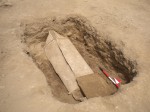 The lead coffin reminds me of the late Roman “burrito” sarcophagus found in a necropolis at the Etruscan site of Gabii in 2009. At a half a ton in lead, it was considerably bulkier than the Leicester coffin, but they are both major signifiers of wealth. Lead coffins tend to preserve remains relatively well, as long as they’re not damaged (like the Grey Friars one) or filled with earth (like the Gabii one). They certainly pose a great challenge to conservators because you can’t just open them and see what’s in there. Lead is highly malleable and easy to damage. Any rough handling would harm the artifact (hence the dangling feet situation) and therefore the human remains within.
The lead coffin reminds me of the late Roman “burrito” sarcophagus found in a necropolis at the Etruscan site of Gabii in 2009. At a half a ton in lead, it was considerably bulkier than the Leicester coffin, but they are both major signifiers of wealth. Lead coffins tend to preserve remains relatively well, as long as they’re not damaged (like the Grey Friars one) or filled with earth (like the Gabii one). They certainly pose a great challenge to conservators because you can’t just open them and see what’s in there. Lead is highly malleable and easy to damage. Any rough handling would harm the artifact (hence the dangling feet situation) and therefore the human remains within.
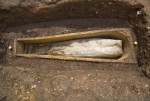 The lead coffin was lifted out of the stone coffin and sent to the University of Leicester lab for analysis where researchers will try to figure out a way to examine the contents without damaging the artifact or the remains.
The lead coffin was lifted out of the stone coffin and sent to the University of Leicester lab for analysis where researchers will try to figure out a way to examine the contents without damaging the artifact or the remains.
The second dig at Grey Friars is now officially over. The decapitated monks were not found, nor were they able to find the remains of the nave. It seems a large portion of the church was completely destroyed by later construction, no foundations left or anything, which makes the discovery of Richard III’s skeleton even more insanely improbable.